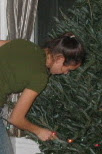Hmm... so I go to take Henry Dog out for a poop and the street is lined with little candle-lit bags. All houses, except mine. So I walk down the street and ask the first person I run into, "What is today?" "What are all the lights for?"
On Christmas Eve at home, some streets do this as a symbol of lighting the way for Jesus. That is kind of a cool tradition. The answer to my question (seeing that it is not yet Christmas eve, and thinking that my endless years schooled at Catholic institutions was failing me) was, "Oh (you dumbass), this is what we do in this neighborhood once a year. It's called Luminaria. And we all put these lights out, there is caroling in the square, and hot chocolate. It is paid for by the town council."
"Oh." I said, and I continue to tell the woman what I just stated about it being a Christmas eve tradition. "Well, this is to include everyone from all denominations."
Okay. Now, this little Stepford area that I live in drives me nuts. First, and this really does not pertain specifically to this neighborhood, Christmas is a Christian holiday. I bet half of what people do - have no idea why they are doing it, such as these bags of lights. Second, let's sing carols in the public square - which are songs about the birth of Jesus... that is sure not to leave anyone from a different denomination out. Third, a Christian tradition of "lighting the way" paid for by the town...
-sigh- I dunno.
Here is a cursory history of luminaries.
Down through the ages, light from fire has served as a destination beacon for weary travelers. Two thousand years ago shepherds marked the way to the manger of the Christ Child with small bonfires. For centuries, to symbolize this tradition, the people of Mexico have gathered on Christmas Eve to light large bonfires in the village commons, to pray, sing and welcome the Christ Child. After the celebration, smaller bonfires were built in front of each home to welcome the Baby Jesus. During the 19th century in northern New Mexico, these bonfires were made from criss-crossed pinõn sticks to light the path to their homes. Early in the 20th century, one family had been unable to adequately prepare the traditional home bonfire because of illness in their family. As the holiday season drew near, the youngest child placed a broken candle in a paper bag partially filled with sand, and placed it outside their home to keep the tradition and welcoming spirit alive. These "little lights" or farolitos have become one of the most popular ways for people to extend this custom to the present day. http://www.simplyluminaries.com/history.html
Sunday, December 19, 2004
Subscribe to:
Post Comments (Atom)

No comments:
Post a Comment